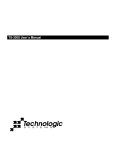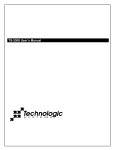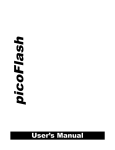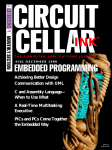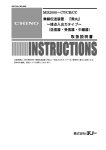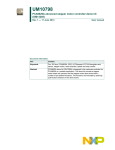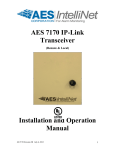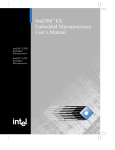Download µFlashTCP User`s Manual v1.1
Transcript
µFlashTCP
Users Manual
Unless otherwise noted, this document and the information herein disclosed are
proprietary to JK microsystems, Inc. Any person or entity to whom this
document is furnished or having possession thereof, by acceptance, assumes
custody thereof and agrees that the document is given in confidence and will not
be copied or reproduced in whole or in part to meet the purposes for which it
was delivered.
The information in this document is subject to change without notice, and should
not be construed as a commitment by JK microsystems, Inc.
JK microsystems, Inc. will make every effort to inform users of substantive
errors.
JK microsystems, Inc. disclaims all liability for any loss or damage resulting from
the use of this manual or any software described herein, including without
limitation contingent, special, or incidental liability.
JK microsystems, Inc. recognizes our customer’s need for a consistent product
and will make every effort to provide one. In order to provide the best possible
product for all of our customers, we reserve the right to make incremental
improvements in our product designs.
µFlashTCP is a trademark of JK microsystems, Inc. MS-DOS is a registered
trademark of Microsoft Corporation. XDOS is a copyright of HBS Corporation.
All other brand and product names are trademarks or registered trademarks of
their respective companies.
µFlashTCP User’s Manual Version 1.1
Copyright © JK microsystems, Inc.
All rights reserved
Printed in U.S.A
Document Part No. 94-0007
Published June 2002
i
µFlashTCP User’s Manual
Limited Warranty
JK microsystems, Inc. warrants each µFlashTCP to be free from defects in
material and workmanship for a period of 90 days from the date of purchase.
This warranty shall not apply to any unit which has been subject to misuse,
neglect, accident, or abnormal conditions of operation.
JK microsystems’ obligation under this warranty is limited to repairing or
replacing, at JK microsystems’ option, any unit returned to the factory
within 90 days of the date of purchase, provided that JK microsystems
determines that the unit is defective and has been used in compliance with the
terms of this warranty. If the failure has been caused by misuse, neglect,
accident, or abnormal conditions of operation, repairs will be billed at a
nominal cost.
The foregoing warranty is exclusive and in lieu of all other warranties,
expressed or implied, including, but not limited to, any warranty of
merchantability or fitness for any particular purpose. JK microsystems shall
not be liable for any special, incidental or consequential damages, whether in
contract, tort, or otherwise.
Important Notice
Life Support / Mission Critical Applications
This product is not fault-tolerant and is not designed, manufactured or
intended for use or resale as on-line control equipment in hazardous
environments requiring fail-safe performance, such as in the operation of
nuclear facilities, aircraft navigation or communication systems, air traffic
control, direct life support machines, or weapons systems, in which the
failure of our hardware or software could lead directly to death, personal
injury, or severe physical or environmental damage.
ii
Table of Contents
Limited Warranty ................................................................................. ii
Table of Contents ................................................................................ iii
Overview .............................................................................................. 1
Features ............................................................................................... 2
Operation ............................................................................................. 3
Getting Started ..................................................................................... 4
Hardware .............................................................................................. 7
Memory Configuration ............................................................................ 7
I/O Configuration ..................................................................................... 7
Clocks ...................................................................................................... 7
Digital I/O Ports ...................................................................................... 8
Programming the Ports ............................................................................ 8
Asynchronous Serial (COM) Ports ......................................................... 9
RS-485 Configuration ............................................................................ 10
Table1: UART Registers ........................................................................ 10
Watchdog Timer ..................................................................................... 11
Ethernet ................................................................................................. 12
DiskOnChip .......................................................................................... 13
Jumpers ................................................................................................. 14
JP2 - Socket Memory Type .......................................................... 14
JP3 - Boot Memory Location ....................................................... 14
Cables and Connectors .......................................................................... 14
Applications ...................................................................................... 16
Supported PC BIOS Functions ............................................................. 16
Interrupts ............................................................................................... 16
Table 3: Hardware Interrupts ................................................................ 17
Utilities ............................................................................................... 19
UP.COM ............................................................................................... 19
DOWN.COM ........................................................................................ 19
FORMAT.COM ................................................................................... 20
EDIT.COM ........................................................................................... 20
SETBAUD.COM .................................................................................. 21
QUIET.COM / NOQUIET.COM ......................................................... 21
DOS .................................................................................................... 22
XDOS Command Reference .................................................................. 22
QuickBASIC Console I/O ................................................................... 25
Specifications ..................................................................................... 26
Contact Information ........................................................................... 27
iii
µFlashTCP User’s Manual
iv
Overview
Overview
The µFlashTCP single board computer is based on the Intel 386Ex
microcomputer. The 386Ex is a high performance, 32-bit, single-chip
microcomputer that is software compatible with the Intel 80386 family of
microprocessors. Onboard Ethernet provides a direct connection to 10BASE-T
networks. DOS compatibility allows development in a familiar environment with
a wide range of tools. High endurance flash memory eliminates EPROM
programming without worry of damaging the onboard non-volatile memory with
repeated program cycles. Applications are uploaded directly into the flash disk.
Expansion options provide high capacity flash storage eliminating the size and
reliability problems associated with electro-mechanical storage devices.
Software development for the µFlashTCP is remarkably simple and quick.
Programs are written on a PC compatible computer in the language of your
choice. After your application has been compiled or assembled and linked into
.EXE or .COM form, it is uploaded to the µFlashTCP’s flash disk with your
favorite telecommunications program using the X-Modem protocol. The
application can then be tested and debugged through the console serial port. When
the application is running to your satisfaction, the startup batch file can be
modified so that the application will load and execute upon reset or powerup.
These features yield a quick and cost effective solution for applications such as
networking, embedded web and serial protocol conversion.
1
µFlashTCP User’s Manual
Features
25MHz Intel 386Ex Processor
10BASE-T Ethernet Controller, NE2000 Compatible
5 Volt DC power
512k Bytes RAM Memory
512k Bytes Flash Memory
High Speed PC Compatible Serial Ports:
1 Full-Function (8-wire) RS-232 Port
1 Software Configurable as 3-wire RS-232 or RS-485
Synchronous 4-Wire Serial Port
3 PC Compatible Counter/Timers
Processor Watchdog (Generates board wide, hardware reset)
10 Digital I/O Lines
32Pin Dip Socket to accept 512k x 8 bit SRAM, 512k x 8 bit Flash, or
M-Systems DiskOnChip 2000.
Support for Multi-I/O Expansion Boards
DOS and BIOS Compatible with the Flashlite386Ex and FlashTCP
Compact Size, 3.75" x 2.50" (95mm x 63.5mm), 1.6oz (45gm)
2
Operation
Operation
The µFlashTCP is configured with two ‘disk drives’ A: and B:. Drive A: contains
the operating system, the BIOS, and utility programs essential to the operation of
the µFlashTCP. Drive A: is read-only. Drive B: is read/write and contains
optional utility programs and is available for user files and applications.
The serial port commonly known as COM2 on the PC is the console for the
µFlashTCP. The port is configured for 9600 baud, 8 data bits, 1 stop bit and no
parity. This is the primary mode of communicating with the µFlashTCP. DOS
and the BIOS treat the console port as the logical devices STDIN and STDOUT.
The second port is addressed and assigned interrupt vectors the same as COM1
on a PC.
When power is applied to the µFlashTCP, or when it is reset, the board goes
through its initialization procedure and then starts DOS. A simple
AUTOEXEC.BAT file is executed and then the board is ready to use. The batch
file performs several functions before the user is given control. The DOS search
path is set, the DOS prompt is set, the CNTL-C flag (discussed later in this
manual) is checked and finally, an attempt is made to execute a file named
STARTUP on the B: drive. This provides a convenient way for custom
applications to execute immediately after initialization of the µFlashTCP. If you
wish to have your application start automatically, create a batch file named
STARTUP.BAT that invokes the program. It is possible, but not recommended,
to rename your application STARTUP.EXE or STARTUP.COM. If this is done
and the program locks up, typing CNTL-C at bootup may not break the program
and exit to the DOS prompt.
!
Although the flash memory devices used have a guaranteed lifetime of
over 10,000 write cycles, it is possible for an application to quickly
wear them out. The flash memory is intended to store programs and
setup data which is normally not changed. Avoid storing data or
frequently changed information on the flash disk.
3
µFlashTCP User’s Manual
Getting Started
To begin development with the µFlashTCP, you will need a PC compatible
computer with a telecommunications program and a free serial port. Connect the
µFlashTCP’s connector J4 to the PC’s serial port with a 9-pin ribbon cable, PN
86-0000. Run the telecommunications program and configure the serial port for
9600 baud, 8 data bits, 1 stop bit and no parity. Apply power to the µFlashTCP,
using our A/C adapter PN 88-0004 or a source of regulated 5V DC capable of
supplying 400mA. J8 pin 1 (square pad on bottom of board) is positive.
GND
RESET/
+5V
J8
JP1
J5
J1
J3
J4
CONSOLE
The µFlashTCP should respond with a welcome message and a B: prompt. Enter
DIR to look at the directory of drive B:. If you do not get a welcome message or
echo of the characters that you type, you need to check your serial port setup.
To test everything but the µFlashTCP, remove the serial cable from J4 and
jumper pins 3 and 5 with a wire or paper clip. If characters typed on the
keyboard are not echoed on the screen, the problem is with your setup. You must
resolve the problem before you can continue.
If you were able to do a DIR, take a few minutes to explore the contents of the
µFlashTCP’s file system. You will find all of the essential utilities on drive A: and
some optional programs on drive B:. Drive A: is write-protected and cannot be
altered. Drive B: is read/write and can be changed or reformatted.
After you have looked at the programs on the µFlashTCP, the next step is to try
to upload a file. This is the procedure for getting a file from your PC to the
µFlashTCP. On the µFlashTCP, type the command UP followed by the name of
4
Getting Started
the file you wish to upload. The µFlashTCP will begin sending characters to your
PC polling it for the file.
On your PC, start the transfer, usually by pressing the PgUp key. The telecomm
program should respond by requesting the file name and protocol. Enter the file
name and select X-Modem for the protocol. The transfer should start and when
it is complete, you should get a new B: prompt on the screen. If the transfer does
not work, the problem is most likely the Carrier Detect signal (pin 1 on the DB-9
connector) into the PC being sensed as low or false. Make sure that the signal is
at least +3 volts into your PC if you are not able to transfer files.
If the transfer terminated without problems, you have a working development
environment for the µFlashTCP controller. At this point, you may wish to
download the files EDIT.COM and BASIC.COM from the µFlashTCP to your
PC. Start the download on the µFlashTCP by typing DOWN BASIC.COM and
pressing Enter. On your PC, begin the transfer, usually by pressing PgDn. After
the file is transferred, repeat the process with EDIT.COM. These files are also
found on the development CD and JK microsystems website.
The µFlashTCP does not have a hardware clock calendar. The time and date will
be maintained by DOS until the power is cycled. If the correct time and date are
required after a power cycle, they must be set either from the command prompt
or via a server on the network. Time and date can be set with the following
commands:
B:\>TIME 13:30:00
B:\>DATE 4-19-2002
Sets the time to 1:30 pm
Sets the date to April 19, 2002
The console output and input on the µFlashTCP can be controlled with the
QUIET and NOQUIET commands. This is useful for applications where both
serial ports must communicate with hardware devices that would be disturbed by
console messages. Before we look at the QUIET and NOQUIET commands, an
overview of the µFlashTCP boot procedure might be helpful.
When power is applied to the µFlashTCP, one of the first things the BIOS
initialization code does is check for a CNTL-C character typed at the console. If
this character is received as soon as the board is powered up or reset, a flag is set
which overrides the quiet state of the console. When DOS runs its
AUTOEXEC.BAT file on drive A:, the state of the CNTL-C flag is also checked
and any user applications set to run on drive B: are not loaded. This insures that a
hung application or quiet console can always be interrupted. Note that the
CNTL-C break must be transmitted to COM2 and 9600 baud, regardless of the
board configuration. This provides a consistent method of interrupting the boot
process.
5
µFlashTCP User’s Manual
Running QUIET will turn off both input and output on the console port, allowing
applications to use it as COM2. Transmitting a CNTL-C immediately after reset
or powerup will restore the console until the next reboot. Running NOQUIET will
restore the default setting of an active console. If COM2 is receiving a constant
stream of binary data that contains the CNTL-C (ASCII 0x03) character, you
may experience trouble booting even in QUIET mode. Please contact
JK microsystems for more information regarding this situation and possible
solutions.
Some applications require switching console states on the fly. The quiet flag is
stored in the flash BIOS and is copied into RAM when the board boots. Once in
RAM, the flag is located at 40:008Bh and occupies the entire byte. Writing a 0 to
this location will enable the console, a 1 will disable the console. The C code
below illustrates this process:
char far *c;
c=(char far *)MK_FP(0x40,0x8B);
*c = 0;
/* turn on console */
*c = 1;
/* turn off console */
If the CNTL-C flag is not set, the AUTOEXEC file will attempt to transfer control
to a file named STARTUP on drive B:. DOS also looks for and, if present, loads
CONFIG.SYS from drive B:.
!
6
A µFlashTCP in quiet mode may appear to be non-functional. When
troubleshooting a system, always try pressing CNTL-C while applying
power.
Hardware
Hardware
Memory Configuration
The 386Ex processor is initially configured in real mode with a physical address
space of 1 megabyte. The SRAM is located between 00000h and 7FFFFh, the
flash is between 80000h and FFFFFh. A 32-pin DIP socket is provided for
additional flash, RAM, or EPROM data. This memory can be accessed by
reprogramming the chip select unit in the 386Ex or by entering protected mode.
During the boot process the BIOS is copied from flash into the top of RAM. The
BIOS executes out of RAM. After the BIOS is copied out of flash, the flash is
removed from the memory map with the exception of a small window near the
1 meg boundary. This allows the reset procedures to work properly while
maintaining user access to peripherals mapped in the higher portion of memory.
When a request for data on drive B: is processed, the flash is mapped in, the drive
read, then mapped out again. If present, the DiskOnChip occupies a block of
memory starting at segment E000 hex.
I/O Configuration
The 386Ex is configured for enhanced DOS mode. This mode provides access to
the PC/AT peripherals such as UARTs, counter/timers, and the interrupt
controller at their traditional I/O port addresses. Other 386Ex peripherals are
accessible in expanded I/O space.
For addressing and programming the peripherals specific to the 386Ex, please
refer to the Intel 386Ex Embedded Microprocessor User’s Manual (Intel
document number 272485-002). The manual is available in PDF format from our
web site at http://www.jkmicro.com
Clocks
The 386Ex is fed with three clock signals. The processor clock of 50 MHz, a
baud rate clock of 1.8432 MHz and the Timer clock at 1.1932 MHz. The
1.1932 MHz timer clock feeds the input of the processor’s three timer channels.
Timer 0 is used for the DOS timer tick and is generally not changed. The two
remaining timers are free for use with applications. These timers can be clocked
either by the external 1.1932 MHz timer clock or by the internal prescaled clock
(PSCLK), depending on the application requirements.
7
µFlashTCP User’s Manual
Digital I/O Ports
The µFlashTCP has 2 ports controlling a total of 10 bits of I/O.
386Ex Port 1 bits 4,5,6 and 7, I/O Address F860 and F862 hex
These signals are available on J5. The data on Port 1 can be read from I/O address
F860 hex. The default configuration is input. Each bit of Port 1 can be
individually configured as an input or output. To configure a bit for output, write
a zero in that bit position to I/O address F864 hex. To output data on Port 1,
write the data to I/O address F862 hex.
P1PIN: F860h, Port Pin Status Register (read only), bits 4-7
P1LTC: F862h, Port Latch Register, bits 4-7
P1DIR: F864h, Port Direction Register, bits 4-7, 0 for output, 1 for
input or open drain output.
P1CFG: F820h, Port Configuration Register, bits 4-7 low, route
P1.4-P1.7 to chip pins (BIOS Default)
386Ex Port 3 bits 0-5, I/O Address F870 and F872 hex
Port 3 bits 0,1,2 and 5 are available on J1, bits 3 and 4 are available on J5. The
data on Port 3 can be read from I/O address F870 hex. The pins default to inputs.
Each bit of Port 3 can be individually configured as an input or output. To
configure a bit as an output, write a zero to that bit position in I/O address F874
hex. To output data on Port 3, write the data to I/O address F872 hex. When used
as inputs, these pins can also be configured to generate processor interrupts.
P3PIN: F870h, Port Pin Status Register (read only), bits 0-5
P3LTC: F872h, Port Latch Register, bits 0-5
P3DIR: F874h, Port Direction Register, bits 0-5, 0 for output, 1 for
input or open drain output.
P3CFG: F824h, Port Configuration Register, bits 0-5 low, route
P3.0-P3.5 to chip pins (BIOS Default)
Be sure to use a read-modify-write process when changing the I/O ports. Pins on
both ports are used to control other on-board functions that can be reprogrammed
or disabled through these configuration registers. See the Intel documentation and
the board schematic for more information on configuring these ports.
Programming the Ports
The I/O ports on the µFlashTCP are mapped into the 386Ex I/O space. Using
the ports requires the use of functions unique to the x86 family of processors.
Creating a pointer to the location may seem logical, but that reference would be in
memory space, not I/O space. Borland C functions inport(port) and
outport( port,value) are 16 bit (word) instructions, inportb( port)
and outportb(port,value) are 8 bit (byte) instructions. These functions
8
Hardware
are part of the dos.h header file. Similar functions (and header files) are available
for other C compilers and languages. The following code illustrates the use of
inportb() and outportb() .
unsigned char port;
port = inportb(PORT_DIR);
/* get value of dir. reg */
port |= PORT_DIR_MASK;
/* set dir. bit for input */
outportb(PORT_DIR, port);
/* write value to dir. reg */
printf("PORT: %X\n", (int)inportb(PORT));
/* read & print port value */
Asynchronous Serial (COM) Ports
The µFlashTCP has 2 serial ports, COM1 and COM2. Both ports are internal to
the 386Ex and are compatible with the 16450 UARTs on a PC. The maximum
data rate is 115k Baud.
COM1 is wired as Data Terminal Equipment (DTE) for connection to a
peripheral such as a modem. This is a full function RS-232 port implementing all
of the handshaking and control lines with the exception of the Ring Indicator
input. See Table 2c for the connector wiring. The UART base address is at I/O
location 3F8h and can be configured to use IRQ 4. This port can also be
configured to use a DMA channel. See the utilities CD or our website for example
code.
COM2 is the default console and is wired as Data Communications Equipment
(DCE) for direct connection to a computer or terminal. This port is software
configurable as a 3 wire RS-232 port implementing RxD and TxD or as a half
duplex RS-485 port. See Table 2d for the connector wiring. The UART base
address is at I/O location 2F8h and can be configured to use IRQ 3.
Table 1 shows the UART configuration and control registers. Please refer to the
Intel 386Ex data sheet for more information on the serial ports and their
configuration.
The DATA and IER registers also hold the baud rate divisor. When the high bit of
the LCR (DLA) is set, the divisor value can be written to DATA and IER.
DATA contains the low byte and IER contains the high byte. To determine the
required divisor, divide 115200 by the required baud rate. Program the divisor
with the nearest integer value. When access to the divisor value is no longer
required, clear the DLA bit.
9
µFlashTCP User’s Manual
7
6
5
4
3
Base
Receive/Transmit Holding Register / Divisor Latch Low (DATA)
Base+1
Interrupt Enable Register (IER)
2
1
0
Data In, Data Out
0
Base+2
Base+3
Base+4
Base+5
Base+6
0
0
0
Modem
Status
Interrupt Identification Register / Divisor Latch High (IIR)
Reserved
Reserved
Reserved
Reserved
Reserved
Line Control Register (LCR)
Divisor
Send Break Parity
Latch
000=None, 001= Odd, 011=Even,
Access
101=Mark, 111=Space
Modem Control Register (MCR)
0
0
0
Loop Back Ext. Int.
Test
Enable
Line Status Register (LSR)
Reserved
Transmit
Transmit
Break
Framing
Register
Buffer
Interrupt
Error
Empty
Empty
Modem Status Register (MSR)
DCD
RI
DSR
CTS
∆
DCD
Receive
Line Status
Transmit
Buffer
Empty
Receive
Buffer
Full
Interrupt Source
Interrupt
00=Modem Status
Pending
01=Transmit Buffer Empty (0=Pending)
10=Receive Buffer Full
11=Receiver Line Status
Stop Bits,
0=1, 1=2
Word Length, 00=5,
01=6,
10=7, 11=8
Out1
RTS
Parity Error Overrun
Error
∆
RI
∆
DSR
DTR
Receive
Buffer Full
∆
CTS
Table1: UART Registers
RS-485 Configuration
The COM2/Console port of the µFlashTCP can be configured and used for
RS-485 communications. In order to avoid conflicts with DOS and the BIOS, it is
first necessary to move the console to COM1. This is done using the utility
program CON2COM1. Please note that COM1 (J3) is pinned out as DTE and you
must use a null modem cable to connect it to a PC serial port.
To enable RS-485 operation (and disable RS-232) on COM2, clear bit 6 of I/O
port F872 hex.
#define EN485_MASK 0xBF
#define EN485_REG 0xF872
outportb(EN485_REG, (inportb(EN485_REG) & EN485_MASK) );
/* change to RS-485 */
Bit 0 of the PINCFG register must be set to allow control of the RS-485 transmit
enable pin. The PINCFG register is located at I/O port F826 hex.
#define PINCFG 0xF826
outportb(PINCFG, (inportb(PINCFG) | 0x01) );
/* connect TE control to chip pkg */
10
Hardware
The RTS line on COM2 is used to control the RS-485 transmitter. To transmit
RS-485 data, set bit 1 of I/O port 2FC hex (mirrored at F8FC hex). To receive
RS-485 data, clear bit 1. Note that the state of the chip pin is the inverse of the
bit in the register (register=1, pin=0).
#define TX_MASK 0x02
#define TX_MASK_REG 0xF8FC
outportb(TX_MASK_REG, (inportb(TX_MASK_REG) | TX_MASK) );
/* enable transmitter */
outportb(TX_MASK_REG, (inportb(TX_MASK_REG) & ~TX_MASK) );
/* disable transmitter */
The RS-485 driver is internally looped back. Characters transmitted will appear
in the UART receiver. Software will need to be written to handle this condition.
Two utility programs are available to aid RS-485 development. 485RX accepts
RS-485 data and displays it on the console. 485TX accepts console data and
sends it out the RS-485 port. The console must be set to COM1 when using
these utilities. Both programs are installed on drive A:.
Watchdog Timer
The Watchdog Timer is a feature of the 386Ex processor chip. When in use, the
watchdog counter decrements once per processor clock cycle. When the counter
reaches zero, the WDTOUT pin is asserted for 8 processor clock cycles. This
signal can be internally routed to IR7 or routed externally to generate a hardware
reset. Software should periodically reload the counter register indicating that it is
behaving properly.
The watchdog system has three modes: General Purpose, Software, and Bus
Monitor. In General Purpose mode the counter can only be reloaded after it times
out. This makes it difficult to use for system protection. The Software mode
allows the countdown register to be reloaded before it times out. This allows
protection against locked up software. The Bus Monitor mode is not applicable
to the µFlashTCP hardware.
To enable the watchdog in Software mode the following sequence must be
followed:
1. Write the upper byte of the reload value to the WDTRLDH
register (F4C0h)
2. Write the lower byte of the reload value to the WDTRLDL
register (F4C2h)
3. Write two sequential words, F01Eh followed by 0FE1h, to the
WDTCLR register (F4C8h)
11
µFlashTCP User’s Manual
Application software must periodically repeat step 3 to refresh the counter and
prevent it from resetting the board. The current value of the counter can be read
from WDTCNTH and WDCNTL at F4C4h and F4C6h. Once enabled in
Software mode, the timer can not be disabled.
The following C code illustrates the above steps:
#define WDTRLDH 0xF4C0
#define WDTRLDL 0xF4C2
#define WDTCLR
0xF4C8
// setup WD timer
// 1.5 sec * 25MHz -> 37.5E6 cycles -> 0x23C3460
outport(WDTRLDH, 0x23C);
// write hi byte of counter value
outport(WDTRLDL, 0x3460);
// write low byte of counter value
outport(WDTCLR, 0xF01E);
outport(WDTCLR, 0x0FE1);
// write enable bytes
The watchdog is active on power up, defaults to general purpose mode and the
counter has an initial value of 3FFFFF hex. The counter can be disabled by setting
bit zero of the WDTEN register at F4CAh. Please refer to the Intel 386EX
Embedded Microprocessor User’s Manual for more information.
Ethernet
The Ethernet port is a 16 bit design that supports direct connection to a
10BASE-T network, jumperless configuration, and NE2000 software
compatibility. The controller has a default base address of 300 hex and IRQ9,
using full duplex twisted pair wiring supporting link detect.
The Ethernet controller requires a software driver to interface with network
software or other programs. The supplied packet driver (NE2000.COM)
configures the chip interrupt, base address and other necessary parameters.
To install the packet driver, type:
B:\> NE2000 0x60 9 0x300
The first parameter (0x60) is the software interrupt that programs will use to
communicate with the driver. The number could be different, but 60h is common.
The driver will install using IRQ9 and I/O base address (300h) and will locate the
MAC (Media Access Control) number stored in the on board configuration
EEPROM. The user must specify the IRQ and base I/O address used by the
controller. When the driver has loaded, it will indicate the system type, software
interrupt, port address, IRQ, and MAC number (Ethernet Address).Note that hex
values are preceded by ‘0x’, consistent with C programming language syntax.
12
Hardware
After the driver has been installed, network software will be able to communicate
with the Ethernet adapter and the network. Users will probably want to modify
their STARTUP.BAT file to automatically load the packet driver.
Other network drivers supporting NE2000 compatible hardware may be used.
Drivers for software requiring NDIS or ODI support are available.
The board has two LEDs that indicated the status of the Ethernet link. The LNK
LED indicates the status of the Ethernet. When illuminated, the µFlashTCP is
receiving the Ethernet ‘heartbeat’ and is connected to a live network. If this LED
is not illuminated, there is a problem with the Ethernet wiring or the network.
The ACT LED indicates activity on the network. The LED will flash when a data
packet is received or transmitted.
DiskOnChip
M-Systems’ DiskOnChip 2000 is a new generation of high performance singlechip Flash Disk. The DiskOnChip has become the standard Flash Disk module
for Embedded Single Board Computers. The DiskOnChip MD2000 and MD2800
are Flash Disks in a standard 32-pin DIP package that has built-in TrueFFS (True
Flash File System) technology, allowing full read/write disk emulation. TrueFFS
provides hard disk compatibility at both the sector and file level. Drive with
capacities from 2 to 144 Mbyte are available. Drives larger than 32Mbyte require
partitioning to allow XDOS to access the entire drive.
Install the DiskOnChip module in the memory expansion socket U11. Note the
location of pin 1. Set the Memory Type jumpers (JP2) for Flash memory. If the
DiskOnChip is installed and functioning, there will be an installation message that
is displayed during the boot process and a C: drive will be available to DOS.
Bios Version 3.3c for uFlashTCP with NE2000 Etherne
DOC Socket Services - Version 0.2
(C) Copyright 1992-1996, M-Systems Ltd.
TrueFFS-BIOS -- Version 3.3.7 for DiskOnChip 2000 (V1.10)
Copyright (C) M-Systems, 1992-1998
DOS Version 3.3c for JK microsystems Flashlite
(C) HBS Corp and JK microsystems 1991-1999
B:\>
If your application requires the µFlashTCP to boot from a DiskOnChip, please
contact JK microsystems for more information and the configuration procedure.
13
µFlashTCP User’s Manual
Jumpers
JP2 - Socket Memory Type
This jumper selects the type of memory in the expansion socket. Available
choices are SRAM or Flash. Other memory types may be supported if their
pinout is compatible with standard SRAM or Flash chips.
Jumper pins 1-2 and 3-4 for SRAM or pins 1-3 and 2-4 for Flash.
Default position: 1-3 and 2-4, Flash memory expansion.
JP3 - Boot Memory Location
This jumper allows the board to boot from the expansion socket. This is useful
when performing field updates of the on-board Flash memory or when using an
operating system other than DOS. Jumper pins 1-3 and 2-4 to boot from the onboard memory or jumper pins 3-5 and 4-6 to boot from the expansion socket.
Default position: 1-3 and 2-4, Boot from on-board flash.
Cables and Connectors
The following tables show the pin and signal names (direction) for each connector.
NOTE:
N/C indicates no connection and PULLUP indicates a 1k ohm pullup
resistor to Vcc. Outputs refer to signals driven by the board and
received by a peripheral. Inputs are driven by a peripheral and received
by the board.
J1
G eneral I/O
J5
M ulti-I/O Bus
V cc
1
2
P 3 .0
Data (P 1.4)
1
2
C LK (P 1.5)
P 3 .1
3
4
P 3 .2
Reset (P 1.6)
3
4
C S (P 1.7)
GN D
P 3 .5
5
6
S S RX C LK
Vcc
5
6
S S TX C LK
7
8
S S RX
IRQ 5 (P 3.3)
7
8
IRQ 6 (P 3.4)
S S TX
9
10
GN D
Vcc
9
10
GN D
Tab le 2a: G eneral I/O P ino ut
Tab le 2e: M ulti- I/O P ino ut
J2
RS - 4 8 5
J8
P o w er
D ATA +
1
+5V
1
GN D
2
R ES ET/
2
D ATA -
3
GN D
3
Table 2 b : RS - 4 8 5 P inout
Tab le 2 f: P o w er P ino ut
COM1 is configured as a DTE port, and is generally used to communicate with a
peripheral device. COM2 is configured as a DCE port, generally being used to
connect the µFlashTCP to another computer. A 10 pin dual row header to 9 pin
D-type connector may be required to connect the expansion card to a peripheral
or computer. See the tables below for connector pinouts.
14
Hardware
J3
C O M 1:
J4
C O M 2:
DC D (in)
1
2
DS R (in)
P ULLU P
1
2
N /C
RxD (in)
3
4
RTS (out)
TxD (out)
3
4
P ULLU P
P ULLU P
TxD (out)
5
6
C TS (in)
RxD (in)
5
6
DTR (out)
7
8
N /C
N /C
7
8
P ULLU P
GN D
9
10
N /C
GN D
9
10
N /C
Table 2c: C O M 1 P inout
Tab le 2 d : C O M 2 P ino ut
The Ethernet port requires a short adapter (PN 86-0018) to connect between the
8 pin header (J10) and the RJ-45 style connector common to 10BASE-T
networks. The default wiring for this adapter allows direct connection to a
network hub with a straight through patch cord. If connection to a PC (without a
hub) is required, the Tx and Rx pairs can be swapped. This can be accomplished
by changing the adapter wiring as outlined below. If external LEDs for link and
activity are required, they can be wired to pins 5 through 8 of J10. 680 ohm series
resistors are provided on the PCB. Table 2g shows cable wiring and pin
numbering information.
J1 0
S traight Thro ugh (to H ub )
RJ- 4 5 P in #
C o lo r
(8 6 - 0 0 1 8 )
µF lashTC P
S ignal N ame
C ro ss- O ver Thro ugh (to P C )
RJ- 4 5 P in #
C o lo r
(8 6 - 0 0 1 8 )
BLK
1
1
BLU
TxD +
3
2
2
O RG
TxD -
6
Y EL
3
3
BLK
RxD +
1
BLU
4
6
Y EL
RxD -
2
O RG
5
LN K LED +
6
LN K LED -
7
A C T LED +
8
A C T LED -
Tab le 2 g: Ethernet P ino ut
12345678
Pin numbering on RJ45 cable plug
Pin 1 of a connector can be identified in several ways. Pin 1 has a square PCB
pad and the others are round. This should be visible on the bottom of the PCB.
Pin 1 will also be identified on the board silkscreen with a ‘1’ and/or a dot. Dual
row headers have ODD numbered pins on one side and EVEN numbered pins on
the other. The dual row header numbering scheme follows the numbering for an
IDC style ribbon cable. This numbering may not be identical to connectors with
discrete wires. Use caution when connecting cables to the µFlashTCP.
15
µFlashTCP User’s Manual
Applications
The µFlashTCP is compatible with a variety of interface drivers, TCP/IP stacks
and network software. Discussion of the installation and operation of these
packages is beyond the scope of this manual. Please refer to the software
documentation or contact JK microsystems.
Some care is required when setting up the µFlashTCP on a network. Contact the
Network Administrator if there are any questions about the required information.
When working with a TCP/IP network, obtain the following information before
starting your configuration: IP Address, Subnet mask, Name Server Address
(DNS), and Gateway address. This information will be required during the
configuration process. Other types of LANs require node names, workgroup
names, etc. Proceed cautiously, networks can be easily disrupted when nodes are
added without careful configuration.
Supported PC BIOS Functions
The Flashlite BIOS supports the following functions (software interrupts)
common to PC compatible computers. Please refer to a DOS/PC reference for
more information on DOS and BIOS software interrupts.
Int 10h, Video Driver, functions 9 and Eh
Int 11h, Get Equipment Configuration
Int 12h, Get Memory Size
Int 13h, Disk Driver, Functions 0-4
Int 14h, Serial Port Driver, Functions 0-3
Int 16h, Keyboard Driver, Functions 0 and 1
Int 19h, Boot System
Int 1Ah, Real Time Clock Driver, Functions 0-5
Int 1Ch, Hook Timer Tick Interrupt
IRQ0, Timer Tick Interrupt
Interrupts
Working with interrupts within the PC architecture can be a bit confusing. The
following information should clarify some of the issues, but it is not a substitute
for a detailed DOS/PC programming reference.
The PC architecture has a 1Kbyte Interrupt Vector Table located at 0000:0000.
This table holds the 4byte address of each Interrupt Service Routine (ISR)
providing a total of 256 interrupts. Most of the interrupts are software
interrupts. Software interrupts provide essential services in a ‘known’ location.
Hardware interrupt requests have an associated interrupt number and ISR in the
vector table. The numbering of hardware interrupts is the largest point of
confusion when working with interrupts on the µFlashTCP. The 386Ex processor
16
Applications
interrupt pins are referred to as INTx in the Intel documentation. PC
programmers are familiar with IRQ (Interrupt Request) numbers and the interrupt
numbers also referred to as INT numbers. The correlation of all these numbers is
critical when using interrupts. Table 3 identifies the IRQ, 386Ex INT number,
function on a standard PC, function on the 386Ex and the interrupt number. You
will notice a large gap in interrupt numbers between IRQ7 and IRQ8. This is due
to the implementation of two cascaded interrupt controllers and the PC legacy.
IRQ0-7 are on the first controller, found in the original PC/XT. IRQ8-15 are on
the second controller implemented in the PC/AT. IRQ2 notifies the system when
an IRQ is triggered on the secondary controller. Table entries without a 386Ex
INT listed are not available on the package pins of the 386Ex.
IRQ
386Ex IN T PC F unction
IRQ 0
IRQ 1
IN T0
IRQ 2
386Ex Function
System Timer
TC U O UT0
K eyboard
P3.2
C ascade
Int. N o. (hex)
08
09
0A
IRQ 3
IN T8
COM2
SIO 1 IN T
0B
IRQ 4
IN T9
COM1
SIO 0 IN T
0C
IRQ 5
IN T1
P3.3
0D
IRQ 6
IN T2
Floppy Disk
P3.4
0E
IRQ 7
IN T3
Parallel P ort
P3.5
IRQ 8
IN T4
Real Time C lock
IRQ 9
IN T5
IRQ 2 (redirected)
IRQ 10
TC U O UT2
IN T6
IRQ 13
IRQ 14
71
TC U O UT1
IRQ 11
IRQ 12
IN T7
0F
70
72
73
M ouse
74
M ath C oprocessor
75
Hard Disk
76
IRQ 15
W DTO UT
77
Table 3: Hardware Interrupts
Each Programmable Interrupt Controller (PIC) has several control registers and
commands, most of which are configured by the BIOS and should not require
modification in most applications. The primary PIC is located at I/O address 20
hex and the secondary controller is at I/O address A0 hex.
17
µFlashTCP User’s Manual
The first command of interest is the Operation Control Word (OCW). Located at
BASE+1, it is the mask byte for the interrupts in that controller. Masked IRQ’s
have a one in the corresponding bit location, enabled interrupts have a zero. Be
sure to only change the mask bits for IRQ’s handled by your program. For
example, to enable IRQ 4:
outportb(0x21,(inportb(0x21) & 0xEF);
The other instruction used is the End Of Interrupt (EOI). This instruction is sent
to the appropriate PIC after an interrupt has been processed. The EOI is
instruction 20 hex and is sent to the BASE address of the controller, for example:
outportb(0x20,0x20);
When servicing an interrupt on the secondary controller (IRQ8-15), it is
necessary to send an EOI to both controllers.
18
Utilities
Utilities
The µFlashTCP comes preloaded with several utilities to aid system
development. These utilities are located on drive A: of the µFlashTCP or the
Utilities disk.
UP.COM
This utility facilitates uploading files to the µFlashTCP via the console port using
the X-MODEM transfer protocol. The utility requires the user to supply the
name of the incoming file. Unless otherwise specified, the file is placed in the
active directory of the current drive. Be sure that B: is the current drive or a
write-protect error will occur when UP tries to write to the read-only A: drive.
B:\>up
Upload file with X-MODEM Protocol
Usage:
up file...
Version 2.0 for JK microsystems Flashlite V25 and 386Ex
B:\>up test.exe
Ready, start X-modem upload now,
Press CNTL-C to abort...
CCCC
B:\>
DOWN.COM
This utility facilitates downloading files from the µFlashTCP via the console port
using the X-MODEM transfer protocol. The utility requires the user to supply
the name of the file to transmit.
B:\>down
Download file with X-MODEM Protocol
Usage:
down file...
Version 1.0 for JK microsystems SBC products
B:\>down test.exe
Ready, start X-modem download now,
B:\>
19
µFlashTCP User’s Manual
FORMAT.COM
If it becomes necessary to reformat the B: drive, FORMAT provides this
function. CAUTION, all information on the drive will be lost during the
formatting process.
B:\>format
Flashlite FLASH Drive Format Program -Version 3.0
System will reboot after successful format...
Press 1 to initialize Drive B as 418 KB disk
Press ESC to exit with no changes
>1
Flash Drive is now formatted
Rebooting system...
EDIT.COM
A simple line editor is included to allow quick creation and modification of batch
files or other text files. EDIT is similar to Microsoft’s EDLIN provided in earlier
versions of MS-DOS. It allows list, insert, delete, and modify. Upon exit, a
backup of the original file is created (filename.BAK) and the edits are saved. If a
backup file with the same name already exists, it is overwritten. A list of
commands and their usage is available by entering ‘h’ at the edit prompt ( >> ).
The name of the file to edit must be supplied following the command EDIT on
the command line.
B:\>edit test.bat
FlashLite Line Editor v1.0
Enter h for help
New File: test.bat
>> i
0: @echo Batch file being processed...
1: mytsr
2: myapp
3: ^Z
>> l
0: @echo Batch file being processed...
1: mytsr
->
2: myapp
>> q
Save before exit (Y,n): y
File Saved
B:\>
20
Utilities
SETBAUD.COM
The default console baud rate can be changed using the SETBAUD.COM utility.
B:\>setbaud
Set console baud rate
Usage: setbaud 9600
Possible baud rates: 1200, 2400, 4800, 9600, 19k, 38k, 56k
Version 1.0 for 386Ex based products
B:\>setbaud 9600
Baud rate change will take effect after next reboot
B:\>
Note that the CNTL-C break must be transmitted to COM2 and 9600 baud,
regardless of the board configuration. This provides a consistent method of
interrupting the boot process.
QUIET.COM / NOQUIET.COM
This pair of utilities control the functionality of the console (COM2) port.
QUIET will disconnect the DOS STDIN and STDOUT functions from the
hardware allowing a user program direct access to COM2. Running this program
appears to do nothing. It has no output and just returns to the DOS prompt; no
changes are apparent. The next time the board is booted, no output will be
present on the console. To restore the console to its active state, boot the board
using the CNTL-C process described previously, and then run NOQUIET.
21
µFlashTCP User’s Manual
DOS
JK microsystems’ controllers use XDOS, a compact operating system for
embedded applications. The XDOS command structure is nearly identical to
MS/PC DOS version 3.3. The switches for the DIR command have been changed
and expanded. XDOS does not support redirected input or output with the use of
< and >, but does support pipes ( | ). None of the external DOS commands are
available due to size constraints. XDOS does not support installable file system
functions.
XDOS Command Reference
In the list below, XDOS commands are followed by a function description and
their format including available parameters and switches. Items in boldface type
must be entered. Capitals or lowercase letters may be used. Items in italics are
parameters. Those in boldface italics must be entered, those in [ ] are optional. All
switches are optional. They are shown as [/X]. Spaces and punctuation are to be
included. An ellipsis ... following items means that you may repeat the items as
often as needed. Do not enter the ellipsis or the square brackets. Most XDOS
commands allow the use of wildcards in filenames and extensions. When
wildcards (?=one character, *=any character or characters) are used, the command
is executed once for each matching file.
Common parameters are:
[ d:]
drive specification - a letter followed by a colon (:), e.g.
A:, if no drive is specified, the default drive is used.
[path]
the path DOS must take in traveling from one directory
to another; directory names are separated by a
backslash (\).
[filename]
up to 8 characters used to name a file.
[.ext]
a three character extension may be added to a filename;
an extension is separated from a filename by a period.
CD / CHDIR
Function:
Changes the current directory
Format:
CD or CHDIR [[d:]path]
COPY
Function:
Format:
Switches:
22
Copies a file, combines two or more files into one file, or
transfers data between files and DOS devices
COPY
[d:][path]filename[.ext][switches]
[+[d:][path]filename[.ext][switches]
[d:][path][filename[.ext]][switches]
/V - verify the contents of new file
/A - copy file in ASCII format
/B - copy file in binary format
DOS
DATE
Function:
Format:
DEL / ERASE
Function:
Format:
Displays or changes the current DOS date.
DATE [mm-dd-yyyy]
Deletes (erases) one or more files from a disk
DEL or ERASE [d:][path][filename[.ext]]
DIR
Function:
Format:
Switches:
MD / MKDIR
Function:
Format:
Lists directory entries
DIR [d:][path][filename[.ext]][switches]
/a - display file attributes
/b - sort by file size (in bytes)
/d - sort entries by date and time
/f - display entries by alphabetic file name order
/n - display entries in directory order (do not sort)
/s - include system and hidden files in output
/h - display this Help screen (any invalid key)
Creates a subdirectory
MD or MKDIR [d:]path
PATH
Function:
Format:
PROMPT
Function:
Format:
Text:
Specifies directories that DOS is to search when trying
to locate executable files
PATH [[d:]path[;[d:]path ...]]
Sets the DOS system prompt
PROMPT [text]
Resulting Character(s):
$t The current time stored by DOS
$d The current date stored by DOS
$p The current directory
$v The version of DOS being used
$n The default drive
$g The character >
$l The character <
$b The character |
$q The character =
$$ The character $
$_ Carriage return plus line feed
23
µFlashTCP User’s Manual
REN
Function:
Format:
RD / RMDIR
Function:
Format:
Renames a file
REN [d:][path]filename[.ext] filename[.ext]
Deletes a subdirectory
RD or RMDIR [d:]path
TIME
Function:
Format:
Displays or changes the current DOS time
TIME [hh:mm:ss.xx]
Function:
Format:
Display the contents of a file
TYPE [d:][path]filename[.ext]
Function:
Format:
Displays the DOS version number
VER
Function:
Format:
Displays the volume label of specified drive
VOL [d:]
TYPE
VER
VOL
24
QuickBASIC
QuickBASIC Console I/O
Some of the code produced by Microsoft QuickBASIC and QuickBASIC
Professional compilers does not execute properly on the µFlashTCP. In the case
of console I/O, we believe that QuickBASIC is generating code for specific
hardware and software not present on the µFlashTCP controller.
There are two problems with console I/O. The first is that a PRINT statement
will not send output to the console port. To output text to the console, open
“cons:” as a file and print to it. The second problem is that an INPUT statement
will not echo the data entered by the user. To work around this problem, we have
added a feature which allows the application to enable a console echo function in
the BIOS. This feature is enabled by setting the byte at 40:8Ah to a one.
Likewise, the local echo is disabled by setting 40:8Ah to a zero.
The following BASIC code demonstrates both of these workarounds:
start:
OPEN “o”, 1, “cons:”
‘
PRINT #1, “What’s your name?
GOSUB echoOn
‘
INPUT name$
‘
GOSUB echoOff
‘
PRINT #1, “”
‘
PRINT #1, “Hi , “; name$
‘
END
console output
“‘ get string
turn on local echo
get the name
turn off local echo
go down a line
print line and name
echoOn:
DEF SEG = &H40
POKE &H8A, 1
RETURN
‘ BIOS data seg
‘ set local echo flag
echoOff:
DEF SEG = &H40
POKE &H8A, 0
RETURN
‘ BIOS data seg
‘ clear echo flag
25
µFlashTCP User’s Manual
Specifications
Supply Voltage:
Supply Current:
Operating Temperature:
Humidity:
5V +/− 5%
400mA (nominal)
-20 to +85 °C
5 - 90 % non-condensing
I/O Port Characteristics:
Symbol
VIL
VIH
VOL
VOH
Parameter
Input Low
Input High
Output Low
Output High
Mating Connectors:
Connector
J1, J3, J4, J5
Mfg
Molex
Oupiin
Molex
Oupiin
Molex
Molex
Molex
Pins
J2, J8
J10
Pins
Mechanical:
Dimensions
Weight
MIN
-0.3
2.0
MAX
0.8
Vcc+0.3
0.45
Vcc-0.5
MFG P/N
22-55-2101
4072-2X05H
16-02-0096
404-PIN-10K
22-01-2031
22-01-2081
08-50-0114
Units
V
V
V
V
Condition
IOL= 8mA
IOH= -8mA
JK micro P/N
28-0030
28-0033
28-0012
28-0037
28-0013
3.75" x 2.50" (95mm x 63.5mm)
1.6oz (45gm)
0.630
0.140
3.75
0.428
JP3
JP2
J8
JP1
J5
2.50
J1
J10
0.15
LNK
J4
J3
0.116 DIA, 4x
0.15
26
ACT
J2
Contact Information
Contact Information
JK microsystems, Inc.
Davis, CA 95616
Telephone:
Fax:
Email:
Web:
(530) 297-6073
(530) 297-6074
[email protected]
http://www.jkmicro.com
Intel Corporation
2200 Mission College Blvd.
P. O. Box 58119
Santa Clara, CA 95052
Telephone:
Fax:
BBS:
Web:
(800) 548-4725, (708) 296-9333
(800) 525-3019
(503) 264-7999
http://www.intel.com
M-Systems
DiskOnChip 2000
39899 Balentine Drive, Suite 335
Newark, CA 94560
Telephone:
Fax:
Email:
Web:
(510) 413-5950
(510) 413-5980
[email protected]
http://www.m-sys.com
Dunfield Development Systems
Micro-Basic, Development Tools
P. O. Box 31044
Nepean, Ontario, Canada K2B 8S8
Telephone:
Fax:
BBS:
Email:
Web:
(613) 256-5820
(613) 256-5821
(613) 256-6289
[email protected]
http://www.dunfield.com
27
µFlashTCP User’s Manual
Rev
----1.1
28
Date
Author
--------- -------19JUN02
EW
Changes
-----------------------------------------------Add revision log.
JP1 not a user jumper, fixed location (2-3).
NMI mode no longer supported.
Clarify RS485 operation, add examples.
Add info on port programming, memory map,
interrutps, clocks and supplied utilities.


































